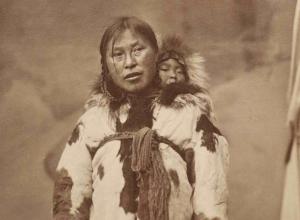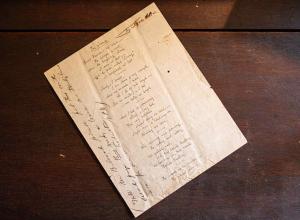The Morgan Presents the First Exhibition of Martin Puryear’s Drawings
New York, NY—One of the most important contemporary American artists, Martin Puryear (b. 1941) is known primarily for the refined elegance of his abstract, hand-made sculptures. However, throughout his career he has consistently turned to drawing to elaborate ideas and forms for works in three dimensions. Martin Puryear: Multiple Dimensions, on view at the Morgan Library & Museum from October 9 through January 10, 2016, is the first exhibition to explore the essential role drawing plays in the artist’s practice. The show includes over seventy works—from quick sketches to monumental, finished compositions—borrowed largely from Puryear’s own collection. Most of the drawings have never been exhibited and span the artist’s undergraduate years to the present. The exhibition will also include a selection of prints and sculptures related to the drawings.
Puryear has described his development as “linear in the sense that a spiral is linear. I come back to similar territory at different times.” The exhibition highlights this iterative process, showing how the artist takes an elemental form and rediscovers and refashions it in diverse media, often over many years, moving among levels of abstraction and experimenting with scale and materials.
“The Morgan is thrilled to present the first exhibition to focus on the role of drawing in Martin Puryear’s art,” said Peggy Fogelman, acting director of the Morgan Library & Museum. “The medium is central to his creative approach, and the works in the show offer an exciting, new perspective on this important contemporary artist.”
THE EXHIBITION
Spanning two galleries, the exhibition opens with an examination of Puryear’s beginnings as a draftsman and printmaker. It introduces visitors to Puryear as a young artist, with figurative drawings and prints from his time spent as a teacher in the Peace Corps in Sierra Leone from 1964 to 1966. While there, Puryear recorded his environment—houses, plants, animals—and the people around him in meticulously detailed drawings. As an example, Gbago (1966), a contour line drawing, depicts a night-watchman with whom Puryear had developed a friendship. Although he made the drawing in Africa, the artist revisited the subject later, while in Stockholm, in a print of the same title that is also on view in the exhibition.
From 1966 to 1968, Puryear studied printmaking at the Swedish Royal Academy of Art in Stockholm. Based on drawings he made in West Africa as well as on observations of architectural elements, the prints he made there typically mix a range of techniques—etching, aquatint, drypoint—all involving incised lines and furrowed surfaces. At that time, Puryear also began making sculpture. As he explained, “it might have been the different ways of incising, which is a kind of carving, that got me considering again the way things are made.” To represent this period, works such as Gate (1966) and Rune Stone (1966) are displayed. Gate, one of the earliest prints Puryear made in Stockholm, marks a shift towards abstraction. The bifurcated arch motif will recur throughout his sculptures, prints, and drawings, including the monumental land work, Bodark Arc (1982)—a drawing for which is also included in the exhibition.
The main part of the exhibition focuses on Puryear’s use and reuse of motifs. Since Puryear turned his focus to sculpture in the late 1960s, his drawings have been mostly preliminary studies for three dimensional works (only rarely does he make a drawing after completing a sculpture). He explores on paper varied materials, angles, details of form, and methods of building and joining, as well as the various vantage points of a sculpture.
One of the dominant motifs is the “head” series, which Puryear revisited in a series of works, in bronze, wood, black Conté crayon, and graphite. In the print Untitled (LA MoCA Portfolio) (1999), his contribution to a benefit for the Los Angeles Museum of Contemporary Art, the motif reads either as a head with hoop earrings or as an inverted jug with handles. The print, which signals Puryear’s return to printmaking after nearly thirty years, introduces the chine collé technique, whereby a thin silky sheet of paper (chine) is laid down to a primary support sheet during printing. As the chine picks up minute particles of ink, it yields extraordinary depth to the etched black area.
The Phrygian cap is another motif to which Puryear has returned in several works over the years. While he experiments with the conical shape of the cap by depicting it upside down or sideways, its significance extends beyond formal concerns. Historically, the cap, popularized by the French Revolution, is a symbol of liberty. More specifically, the shape of Big Phrygian (2010-14), one of two large sculptures in the exhibition, evokes the red cap worn by an emancipated slave in a French 18th century engraving that Puryear came across after he started working on the sculpture.
The exhibition also presents several of Puryear’s projects related to public sculptures, an important aspect of his practice. These large-scale pieces rehearse the organic shapes of his overall body of work. Like his indoor sculptures, the public commissions are developed through studies on paper and models. The clean elegance of the finished works belies the complexity of the thought process made visible in the drawings. Works presented include drawings and a small model for Bearing Witness (1994), a sculpture in the Federal Triangle in Washington, D.C., and Shackled (2014), a small-scale iron version of a 40-foot-tall sculpture that will be installed in New York’s Madison Square Park in 2016, among others.
ABOUT MARTIN PURYEAR
Over the last fifty years, Martin Puryear has created a body of work that defies categorization and draws on diverse cultures and histories. His sculpture combines modernist abstraction with traditions of crafts and woodworking, in shapes informed by the natural world and by ordinary objects and made with materials such as wood, tar, wire mesh, bronze, and stone.
Born in 1941 in Washington, D.C., Puryear was educated at Catholic University, the Royal Swedish Academy of Arts in Stockholm, and Yale University. His longstanding interests in nomadic cultures, furniture and boat building techniques, ornithology, falconry, and archery, all inform his work. “I think there are a number of levels at which my work can be dealt with and appreciated,” Puryear has said. “It gives me pleasure to feel there’s a level that doesn’t require knowledge of or immersion in the aesthetic of a given time or place.”
His first one-person museum exhibition was in 1977 at the Corcoran Gallery of Art in Washington, D.C. and since that time his work has been exhibited throughout the world, with public commissions in Europe, Japan, and the United States. He represented the United States at the 1989 São Paulo Bienal, where he was awarded the festival’s Grand Prize, and his work was included in the 1992 Documenta. He received a MacArthur Foundation award in 1989, the Gold Medal in Sculpture by the American Academy of Arts and Letters in 2007, and has recently been awarded the Presidential Medal of the Arts.
EXHIBITION CATALOGUE
The accompanying catalogue, Martin Puryear: Multiple Dimensions, explores the artist's process, featuring numerous drawings, prints, and small-scale sculptures that have never before been published. This catalogue is the first to examine Puryear’s work across media, providing invaluable insight into his visual thinking, from sketches to working drawings and constructions for sculpture. Handsomely illustrated with nearly 120 color plates that demonstrate the evolution of Puryear’s ideas between drawings, prints, and sculptures, this beautiful volume draws back the curtain on the methodology of this important and enigmatic artist. Mark Pascale, curator in the Department of Prints and Drawings at the Art Institute of Chicago and an expert on modern and contemporary printmaking techniques, will contribute an essay on Puryear’s print production. Ruth Fine, recently retired curator of special projects at the National Gallery of Art, Washington, DC, will provide insights into the artist’s drawings in her essay.















